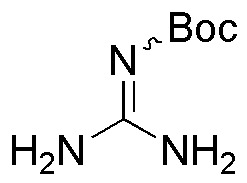N-Boc-guanidine is widely utilized in research focused on:
- Pharmaceutical Development: It serves as a key intermediate in the synthesis of various pharmaceutical compounds, particularly in the development of drugs targeting neurological disorders.
- Peptide Synthesis: This compound is essential in solid-phase peptide synthesis, enabling the formation of complex peptides with improved stability and bioactivity.
- Bioconjugation: N-Boc-guanidine is used in bioconjugation processes to attach biomolecules to surfaces or other molecules, enhancing the functionality of diagnostic and therapeutic agents.
- Research in Catalysis: It acts as a ligand in catalysis research, facilitating reactions that are crucial for developing new materials and chemical processes.
- Material Science: The compound is applied in the formulation of polymers and resins, contributing to the development of materials with desirable mechanical and thermal properties.
General Information
Properties
Safety and Regulations
Applications
N-Boc-guanidine is widely utilized in research focused on:
- Pharmaceutical Development: It serves as a key intermediate in the synthesis of various pharmaceutical compounds, particularly in the development of drugs targeting neurological disorders.
- Peptide Synthesis: This compound is essential in solid-phase peptide synthesis, enabling the formation of complex peptides with improved stability and bioactivity.
- Bioconjugation: N-Boc-guanidine is used in bioconjugation processes to attach biomolecules to surfaces or other molecules, enhancing the functionality of diagnostic and therapeutic agents.
- Research in Catalysis: It acts as a ligand in catalysis research, facilitating reactions that are crucial for developing new materials and chemical processes.
- Material Science: The compound is applied in the formulation of polymers and resins, contributing to the development of materials with desirable mechanical and thermal properties.
Documents
Safety Data Sheets (SDS)
The SDS provides comprehensive safety information on handling, storage, and disposal of the product.
Product Specification (PS)
The PS provides a comprehensive breakdown of the product’s properties, including chemical composition, physical state, purity, and storage requirements. It also details acceptable quality ranges and the product's intended applications.
Certificates of Analysis (COA)
Search for Certificates of Analysis (COA) by entering the products Lot Number. Lot and Batch Numbers can be found on a product’s label following the words ‘Lot’ or ‘Batch’.
*Catalog Number
*Lot Number
Certificates Of Origin (COO)
This COO confirms the country where the product was manufactured, and also details the materials and components used in it and whether it is derived from natural, synthetic, or other specific sources. This certificate may be required for customs, trade, and regulatory compliance.
*Catalog Number
*Lot Number
Safety Data Sheets (SDS)
The SDS provides comprehensive safety information on handling, storage, and disposal of the product.
DownloadProduct Specification (PS)
The PS provides a comprehensive breakdown of the product’s properties, including chemical composition, physical state, purity, and storage requirements. It also details acceptable quality ranges and the product's intended applications.
DownloadCertificates of Analysis (COA)
Search for Certificates of Analysis (COA) by entering the products Lot Number. Lot and Batch Numbers can be found on a product’s label following the words ‘Lot’ or ‘Batch’.
*Catalog Number
*Lot Number
Certificates Of Origin (COO)
This COO confirms the country where the product was manufactured, and also details the materials and components used in it and whether it is derived from natural, synthetic, or other specific sources. This certificate may be required for customs, trade, and regulatory compliance.


